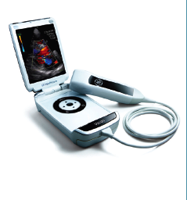News in brief from the world of cardiology.

New pocket-sized visualisation tool
This new pocket-sized visualisation tool provides ultrasound technology at the point-of-care. Similar in size to a mobile phone and weighing less than one pound, it can give high quality colour images enabling physicians to take a quick look inside the body and detect disease earlier. Vscan™ is marketed by GE Healthcare and has received the CE Mark by the European Union.
Heart failure report published
A comprehensive review of the quality of heart failure care in England Bridging the quality gap: heart failure, has been published by The Health Foundation. It highlights that prevention is key to improving outcomes for people with heart failure and reports that survival rates are improving. But it also draws attention to the slow improvement in services in England compared to international comparators with guidelines not being adequately followed.
“We would welcome more strategic attention to be paid to heart failure, particularly around prevention and screening,” said Stephen Thornton, Chief Executive at the Health Foundation.
A copy of the report can be downloaded at www.health.org.uk
New SIGN diabetes guidance
The Scottish Intercollegiate Guidelines Network (SIGN) has published new guidance on the management of diabetes. The full guidance is available on www.sign.ac.uk and provides recommendations on:
• lifestyle interventions for people with type 1 and type 2 diabetes
• managing psychosocial issues
• managing type 1 diabetes
• glucose-lowering therapies in people with type 2 diabetes including direction on the use of newer agents such as DPP-4 inhibitors
• managing cardiovascular, kidney and foot diseases
• preventing visual impairment
• managing type 1, type 2 and gestational diabetes during pregnancy.
• Prevention of diabetes and prediabetes are not covered in the guidance.
Study to assess new stent graft system

A new study is assessing the safety and performance of this new stent graft system. The Incraft™ stent developed by Cordis is being assessed in patients with abdominal aortic aneurysm (AAA) in Germany in the INNOVATION trial. AAA is suffered by 27 million people worldwide.
SMC recommends saxagliptin
The Scottish Medicines Consortium (SMC) has recommended saxagliptin (OnglyzaTMθ) for people with type 2 diabetes in Scotland as add-on combination therapy with metformin, when metformin alone, with diet and exercise, does not provide adequate glycaemic control. It is restricted to use in patients only when the addition of sulphonylureas is not appropriate and represents an alternative to other agents, such as thiazolidinediones.
Pacemaker development enables patients to access MRI scans
A second-generation pacing system (Advisa DR MRI™ Surescan™, Medtronic) has been approved for use in MRI machines in the UK. First patients have already been fitted with the new pacemaker in the UK, which enables them to have access to full body scans.
“Existing pacemaker technology meant that MRI scans were not safe for over a quarter of a million patients because of the strong magnetic fields it uses,” said Dr Jonathan Lyne, cardiologist at the Royal Brompton Hospital, London. “These patients will not need more invasive or complicated diagnostic procedures and will lead to speedier and more accurate diagnoses.”
Teach me to pace – the dilemma of the new registrar
 What is it like to attend a workshop on bradycardia and pacing? Do trainees really benefit from these short sponsored courses, what’s involved and how can one enrol? These questions our answered by Hammersmith Hospital, Cardiology Registrar, Henry Savage (above). To see his review go to our Arrhythmia Watch website, www.arwatch.co.uk. It’s free to register and read his report alongside other developments in the heart rhythm management area.
What is it like to attend a workshop on bradycardia and pacing? Do trainees really benefit from these short sponsored courses, what’s involved and how can one enrol? These questions our answered by Hammersmith Hospital, Cardiology Registrar, Henry Savage (above). To see his review go to our Arrhythmia Watch website, www.arwatch.co.uk. It’s free to register and read his report alongside other developments in the heart rhythm management area.
IFCC HbA1c reporting guide launched
A new guide to help healthcare professionals better understand the new IFCC units for reporting HbA1c was launched at the Diabetes UK Annual Professional Conference in Liverpool recently.
Produced in association with Diabetes UK, the pocketbook HbA1c in Diabetes – case studies using IFCC units is aimed at nurses, doctors and scientists involved in the management of diabetes in the UK. It summarises the key issues around the switch from DCCT percentage HbA1c values to the internationally-recognised IFCC units of mmol/mol. Reporting of these units only is scheduled for June 2011 in the UK.
For more information or to place an order visit www.wiley.com/go/endocrinology
European study shows only half of patients given correct cholesterol targets
Only half of all patients at high risk of heart disease are given correct targets for lowering their cholesterol levels according to a study of 25,250 patients in Germany published online in the European Heart Journal (doi:10.1093/eurheartj/ehq026).
The study investigated the way primary care doctors assessed their patients’ risk factors and other health problems when deciding on cholesterol-lowering targets, and although the research focused on German doctors and their patients, the authors believe that it reflects a similar picture in the rest of Europe.
The researchers found that in the survey of 907 doctors, just over half of male patients (55%) and less than half (49%) of female patients were assigned correct low-density lipoprotein cholesterol targets.
“We believe efforts should be made to make guidelines simpler and easier to understand and follow; instruments to identify high-risk patients more easily should be developed; and special attention should be paid to women and patients without known cardiovascular disease, but with an accumulation of risk factors, since both groups appear frequently to escape the notice of doctors for aggressive cholesterol-lowering treatment,” said Professor Heribert Schunkert (Universitätsklinik Schleswig Holstein, Lübeck, Germany) who led the research.
